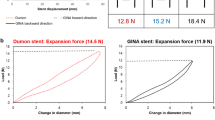Abstract
Purpose
At the moment, there is an inadequate margin fit of commercially available stoma buttons. The aim of the present study was to develop a customized short tracheal cannula based on digital data. Furthermore, the applied material has to be evaluated considering germ colonization and appropriate cleaning procedures.
Methods
Computed tomographies of 53 patients who underwent laryngectomy were surveyed. Based on the digital data, a customized short tracheal cannula was created and manufactured from silicone. The new cannula was incorporated in ten patients and worn for 4 weeks. A clinical examination of an otolaryngologist and subjective assessment of the patients were carried out. Furthermore, microbiological test considering germ colonization was performed.
Results
The customized short tracheal cannula could be incorporated in all patients. The clinical results showed no irritation or mucosal lesions. The subjective individual evaluation by the patients was promising. The proposals for improvement could be considered. The microbiological examination revealed a higher contamination of the silicone compared to the silver cannulas. Both chemical and mechanical decontamination showed sufficient results.
Conclusion
A workflow for development and manufacturing of a customized short tracheal cannula from digital data could be established. The cannula is compatible to standard equipment and routine cleaning procedures. Clinical studies are required to evaluate the potential benefit for patients.





Similar content being viewed by others

References
Schantz SP, Yu G (2002) Head and neck cancer incidence trends in young Americans, 1973-1997, with a special analysis for tongue cancer. Arch Otolaryngol Head Neck Surg 128:268–274
Fligiel SE, Roth MD, Kleerup EC, Barsky SH, Simmons MS, Tashkin DP (1997) Tracheobronchial histopathology in habitual smokers of cocaine, marijuana, and/or tobacco. Chest 112:319–326
Barsky SH, Roth MD, Kleerup EC, Simmons M, Tashkin DP (1998) Histopathologic and molecular alterations in bronchial epithelium in habitual smokers of marijuana, cocaine, and/or tobacco. J Natl Cancer Inst 90:1198–1205
Brennan JA, Boyle JO, Koch WM, Goodman SN, Hruban RH, Eby YJ, Couch MJ, Forastiere AA, Sidransky D (1995) Association between cigarette smoking and mutation of the p53 gene in squamous-cell carcinoma of the head and neck. N Engl J Med 332:712–717
Rudat V, Wannenmacher M (2001) Role of multimodal treatment in oropharynx, larynx, and hypopharynx cancer. Semin Surg Oncol 20:66–74
Huber MA, Terezhalmy GT (2005) The medical oncology patient. Quintessence Int 36:383–402
Flach M, Böhme W (1981) Individually manufactured plastic cannulas for laryngectomized patients (author's transl). Laryngol Rhinol Otol (Stuttg) 60:359–360
Reitemeier B, Schmidt A (1994) The care of laryngectomized patients with individually fitted tracheostomy cannulae. J Facial Somato Prosthet 1:13–17
Reitemeier B, Päßler K, Richter G, Schaal W, Schmidt A (1997) Zur Versorgung laryngektomierter Patienten mit individuellen Trachealkanülen. Quintessenz Zahntech 23:167–174
Lewin JS, Lemon J, Bishop-Leone JK, Leyk S, Martin JW, Gillenwater AM (2000) Experience with Barton button and peristomal breathing valve attachments for hands-free tracheoesophageal speech. Head Neck 22:142–148
Lewin JS, Montgomery PC, Hutcheson KA, Chambers MS (2009) Further experience with modification of an intraluminal button for hands-free tracheoesophageal speech after laryngectomy. J Prosthet Dent 102:328–331. doi:10.1016/S0022-3913(09)60185-2
Europäisches Arzneibuch Basiswerk (2011) Amtliche Deutsche Ausgabe 2013. ISBN: 978-3-7692-6220-9
Klemm E, Nowack A (2012) Trachealkanülen und Kanülenpflege. Springer, Heidelberg
Fuchs P (1966) Germ content of non-hardening plastic materials. Dtsch Zahnarztl Z 21:163–167
Singer MI (1983) Tracheoesophageal speech: vocal rehabilitation after total laryngectomy. Laryngoscope 93:1454–1465
Chuanjun C, Zhiyuan Z, Shaopu G, Xinquan J, Zhihong Z (2002) Speech after partial glossectomy: a comparison between reconstruction and nonreconstruction patients. J Oral Maxillofac Surg 60:404–407
Müller R, Reitemeier B (2009) Palatal orthosis as an aid in rehabilitation of patients with dysfunctions or defects of the soft palate after tumor therapy. Laryngorhinootologie 88:80–83. doi:10.1055/s-0029-1213766
Reiter R, Haase S, Brosch S (2012) Orofacial clefts. Laryngorhinootologie 91:84–95. doi:10.1055/s-0031-1285886
Hilgers FJM, Ackerstaff AH (2006) Development and evaluation of a novel tracheostoma button and fixation system (Provox LaryButton and LaryClip adhesive) to facilitate hands-free tracheoesophageal speech. Acta Otolaryngol 126:1218–1224
Reitemeier B, Andrä H (2000) Optimization of the conditions for rehabilitating olfactoryfunction in patients with laryngectomies. J Facial Somato Prosthet 6:81–87
Acknowledgments
The present study was supported by the Arbeitsgemeinschaft industrieller Forschungsvereinigungen (Consortium of industrial research) “Otto von Guericke” e.V. (AiF) (KF 0107603VT7).
Conflict of interest
The authors declare that they have no conflict of interest.
Author information
Authors and Affiliations
Corresponding author
Rights and permissions
About this article
Cite this article
Müller, R., Meißner, H., Böttcher, G. et al. Development and first data of a customized short tracheal cannula based on digital data. Support Care Cancer 23, 3089–3093 (2015). https://doi.org/10.1007/s00520-015-2682-0
Received:
Accepted:
Published:
Issue Date:
DOI: https://doi.org/10.1007/s00520-015-2682-0



